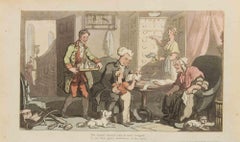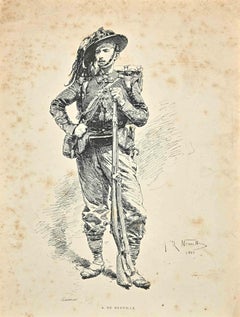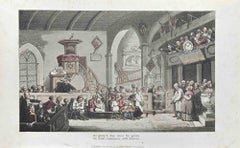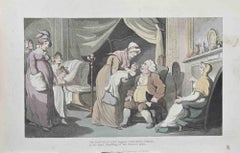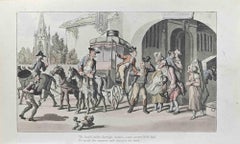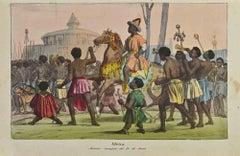19th Century Figurative Prints
to
1,322
6,367
1,068
177
49
38
Overall Width
to
Overall Height
to
5,535
347
111
56
35
25
17
6
2
267
122
110
109
101
3,649
7,713
24,787
6,798
288
596
1,431
1,215
1,236
2,085
2,939
5,174
2,854
1,425
3,109
4,509
3,146
42
5,336
2,699
2,110
1,798
1,549
1,067
864
589
559
515
506
503
437
295
248
240
226
220
215
202
4,425
2,148
702
674
436
335
5,753
4,235
765
Period: 19th Century
The Tender Nurse's Care - Etching by Thomas Rowlandson - 1817
Located in Roma, IT
Etching and aquatint realized by Thomas Rowlandson in 1817. Plate from "The Dance of Life" by William Combe.
Very good condition.
Thomas Rowlandson (1757-1827) was an english artis...
Category
Modern 19th Century Figurative Prints
Materials
Etching
$160 Sale Price
25% Off
Soldier - Lithograph by Alphonse de Neuville - 1883
Located in Roma, IT
Soldier is an lithograph realized by Alphonse de Neuville in 1883.
Signed on Plate.
Good conditions.
The Artwork is depicted through soft strokes.
Category
Modern 19th Century Figurative Prints
Materials
Lithograph
By Piety's Due Rites tis Given - Etching by Thomas Rowlandson - 1817
Located in Roma, IT
Etching and aquatint realized by Thomas Rowlandson in 1817. Plate from "The Dance of Life" by William Combe.
Very good condition.
Thomas Rowlandson (1757-1827) was an english artis...
Category
Modern 19th Century Figurative Prints
Materials
Etching
The Dance of Life Begins - Etching by Thomas Rowlandson - 1817
Located in Roma, IT
Etching and aquatint realized by Thomas Rowlandson in 1817. Plate from "The Dance of Life" by William Combe.
Very good condition.
Thomas Rowlandson (1757-1827) was an english artis...
Category
Modern 19th Century Figurative Prints
Materials
Etching
$160 Sale Price
25% Off
Tis hop'd, Miss Foreign Scenes - Etching by Thomas Rowlandson - 1817
Located in Roma, IT
Etching and aquatint realized by Thomas Rowlandson in 1817. Plate from "The Dance of Life" by William Combe.
Very good condition.
Thomas Rowlandson (1757-1827) was an english artis...
Category
Modern 19th Century Figurative Prints
Materials
Etching
Ancient African Customs - Lithograph by Auguste Wahlen - 1844
Located in Roma, IT
Africa is a lithograph realized by Auguste Wahlen in 1844.
Hand colored.
Good condition.
At the center of the artwork is the original title "Africa" and subtitle "Marcia trionfale...
Category
Modern 19th Century Figurative Prints
Materials
Lithograph
$192 Sale Price
35% Off
Teruta-hime - Woodcut by Utagawa Kuniyoshi - 1842/43
Located in Roma, IT
Teruta-hime is a woodcut print realized by Utagawa Kuniyoshi in 1842/43.
Lifetime impression of chuban tate-e, it depicts Teruta-hime carrying a bucket of water through the snow, wi...
Category
Modern 19th Century Figurative Prints
Materials
Woodcut
Bijinga - Woodcut by Utagawa Kunisada - 1844
Located in Roma, IT
Bijinga is an original artwork realized in the half of the 19th Century by Utagawa Kunisada (1786-1865).
From the series "SHyakunin isshu esho" (Girl's pictures and 100 poets' card...
Category
Modern 19th Century Figurative Prints
Materials
Woodcut
In His Opprefs'd and Adverse Hour- Etching by Thomas Rowlandson - 1817
Located in Roma, IT
Etching and aquatint realized by Thomas Rowlandson in 1817. Plate from "The Dance of Life" by William Combe.
Very good condition.
Thomas Rowlandson (1757-1827) was an english artis...
Category
Modern 19th Century Figurative Prints
Materials
Etching
Narciso and Echo - B/W Etching after Claude Lorrain - 1815
Located in Roma, IT
Beautiful Artist’s Proof, representing the myth of Narcissius and the nymph Eco, draw by "the Metamorphosis" by Publio Ovidio Nasone.
This aquatint, by Ludovico Caracciolo (engraver...
Category
Old Masters 19th Century Figurative Prints
Materials
Etching, Aquatint
Genji in the Twelve Months - Woodcut by Utagawa Toyokuni III - 1858
Located in Roma, IT
Genji in the Twelve Months / The Tenth Month (Moto) is a tryptich woodcut print realized by Utagawa Toyokuni III in 1858.
Very good condition except for some minor signs of wear.
Category
Modern 19th Century Figurative Prints
Materials
Woodcut
Two Botanical Lithographs, Flora Of America
Located in SAINT-OUEN-SUR-SEINE, FR
Étienne DENISSE (1785-1861)
Gombeau Edible and Trompette.
Collection of the most remarkable Flowers and Fruits, natural size.
Two lithographs enhanced with watercolor.
Around 1830.
F...
Category
19th Century Figurative Prints
Materials
Paper, Watercolor
Biest Hymen, Whose Propitious Hour Restore - Etching by Thomas Rowlandson - 1817
Located in Roma, IT
Etching and aquatint realized by Thomas Rowlandson in 1817. Plate from "The Dance of Life" by William Combe.
Very good condition.
Thomas Rowlandson (1757-1827) was an english artis...
Category
Modern 19th Century Figurative Prints
Materials
Etching
Romantic Drama - Woodcut Print by Utagawa Kunisada - 1850s
Located in Roma, IT
Romantic Drama is an original modern artwork realized by Utagawa Kunisada in 1853.
Woodcut print oban diptych format from a tryptich. Signature: Toyokuni ga. Publisher: Tsujiokaya B...
Category
Modern 19th Century Figurative Prints
Materials
Woodcut
The Ferns - Lithograph by Vincenzo Tenore - 1870s
Located in Roma, IT
Lithograph hand watercolored.
Plate from "Atlante di Botanica popolare ossia Illustrazione di Piante Notevoli di ogni famiglia" (Atlas of popular botany or illustration of notable ...
Category
Modern 19th Century Figurative Prints
Materials
Lithograph
Nymph collecting the flowers - Lithograph, 1897
Located in Paris, IDF
Fernand Toussaint
Nymph collecting the flowers, 1897
Original lithograph
Printed signature in the plate
Printed on paper vélin
Size 40 x 29 cm (c....
Category
Art Nouveau 19th Century Figurative Prints
Materials
Lithograph
$462 Sale Price
22% Off
The Physiognomy - Skulls - Original Etching by Thomas Holloway - 1810
Located in Roma, IT
The Physiognomy - Skulls is an original etching artwork realized by Thomas Holloway for Johann Caspar Lavater's "Essays on Physiognomy, Designed to Promote the Knowledge and the Love...
Category
Modern 19th Century Figurative Prints
Materials
Etching
Kabukie - Woodcut by Utagawa Kunisada - 1850s
Located in Roma, IT
Kabukie is an original artwork realized in the 1850s by Utagawa Kunisada (1786-1865).
Oban from a triptych.
An actor in the role of Otokodate Abe no Homei stands ready at night in...
Category
Modern 19th Century Figurative Prints
Materials
Woodcut
Temple of Neptune Pesto - Lithograph - 1862
Located in Roma, IT
Uses and Customs - Temple of Neptune Pesto is a lithograph on paper realized in 1862.
The artwork belongs to the Suite Uses and customs of all the peoples of the universe: " History...
Category
Modern 19th Century Figurative Prints
Materials
Lithograph
Journal Des Demoiselles - Original Lithograph by Paul Lacourière - 19th Century
Located in Roma, IT
Plate from Journal Des Demoiselles is an original artwrok realized in the 19th century by Paul Lacourière
Mixed colored lithograph from the Le...
Category
Modern 19th Century Figurative Prints
Materials
Lithograph
Boy at the source / - Elixir of Life -
Located in Berlin, DE
Hans Thoma (1839 Bernau - 1924 Karlsruhe), Boy at the source, 1897. Algraph on strong wove paper after a drawing from 1897, published by Breitkopf und Härtel in Leipzig as ‘Zeitgenös...
Category
Realist 19th Century Figurative Prints
Materials
Paper
$265 Sale Price
20% Off
The Skull - Original Lithograph by Paul Gervais - 1854
By Paul Gervais
Located in Roma, IT
The Skull is an original lithograph on ivory-colored paper, realized by Paul Gervais (1816-1879). The artwork is from The Series of "Les Trois Règnes de la Nature", and was published...
Category
Modern 19th Century Figurative Prints
Materials
Lithograph, Paper
Tengmalm's Owl - Woodcut Print by Alexander Francis Lydon - 1870
Located in Roma, IT
Tengmalm's Owl is a modern artwork realized in 1870 by the British artist Alexander Francis Lydon (1836-1917).
Woodcut print on ivory-colored paper.
Hand-colored, published by Lond...
Category
Modern 19th Century Figurative Prints
Materials
Woodcut
Disparate Alegre - Etching - 1875
Located in Roma, IT
Disparate alegre - from Los Proverbios is an original black and white etching realized by Francisco Goya (1746-1828).
The artwork is the plate n. 12 ...
Category
Old Masters 19th Century Figurative Prints
Materials
Etching, Aquatint
Uses and Customs - Romanian - Lithograph - 1862
Located in Roma, IT
Uses and Customs -Romanian is a lithograph on paper realized in 1862.
The artwork belongs to the Suite Uses and customs of all the peoples of the universe: " History of the governme...
Category
Modern 19th Century Figurative Prints
Materials
Lithograph
Courtesan - Woodcut by Keisai Eisen - 1830
By Keisai Eisen
Located in Roma, IT
Courtesan is an original modern artwork realized by Keisai Eisen in the first half of the 19th Century.
Signed and inscribed on plate.
Total dimension...
Category
Modern 19th Century Figurative Prints
Materials
Paper, Woodcut
They Spin Finely (Hilan Delgado) - Etching by Francisco Goya - 1881
Located in Roma, IT
They spin finely (Hilan delgado) is a black and White aquatint, drypoint, and etching printed in blue-black ink on laid paper from Caprichos realized after Francisco Goya in 1881-188...
Category
Modern 19th Century Figurative Prints
Materials
Etching
For my Own Good and Yours' I'm Bent- Etching by Thomas Rowlandson - 1817
Located in Roma, IT
Etching and aquatint realized by Thomas Rowlandson in 1817. Plate from "The Dance of Life" by William Combe.
Very good condition.
Thomas Rowlandson (1757-1827) was an english artis...
Category
Modern 19th Century Figurative Prints
Materials
Etching
George Romodo - An Eccentric Mimic
Located in Bournemouth, Dorset
George Romondo, was a diminutive 18th-century performer known as the “eccentric mimic.”
Born in about the year 1765 in Lisbon, Portugal, Romondo’s unusual talent was matched by an...
Category
19th Century Figurative Prints
Materials
Engraving
$102 Sale Price
20% Off
Ya van Desplumados - Etching by Francisco Goya - 1881
Located in Roma, IT
Ya van desplumados is a black and White aquatint, drypoint, and etching printed in blue-black ink on laid paper from Caprichos realized after Francisco Goya in 1881-1886.
6th Editio...
Category
Modern 19th Century Figurative Prints
Materials
Etching
Danky, Vanity Fair legal chromolithograph of a judge, 1898
Located in Melbourne, Victoria
Vanity Fair legal portrait of William Otto Adolph Julius Danckwerts.
380mm by 260mm (sheet)
Category
Victorian 19th Century Figurative Prints
Materials
Lithograph
Divinity (from Parthenon) - Woodcut Print - 1862
Located in Roma, IT
Divinity is an artwork realized from 1856 to 1862 .
Black and white woodcut.
Category
Modern 19th Century Figurative Prints
Materials
Woodcut
Rafflesia Arnoldii - Lithograph by Vincenzo Tenore - 1870s
Located in Roma, IT
Lithograph hand watercolored.
Belongs to the Series "Atlante di Botanica popolare ossia Illustrazione di Piante Notevoli di ogni famiglia" (Atlas of popular botany or illustration o...
Category
Modern 19th Century Figurative Prints
Materials
Lithograph
Oriental Woman (Femme du Riff) - original lithograph (1897-1898)
By Louis-Abel Girardot
Located in Paris, IDF
Louis Abel GIRARDOT (1848 - 1937)
Oriental Woman (Femme du Riff), 1897
Original lithograph
Printed signature in the plate
On vellum 40 x 31 cm (c. 16 x 12")
INFORMATION : Published...
Category
Art Nouveau 19th Century Figurative Prints
Materials
Lithograph
Marphise (Tire de l'Arioste), Old Masters Lithograph after Eugene Delacroix
Located in Long Island City, NY
Eugene Delacroix, After by Eugene LeRoux, French (1798 - 1863) - Marphise (Tire de l'Arioste), Year: circa 1850, Medium: Lithograph, Image Size: 10.5 x 13 inches, Size: 19.25 x 2...
Category
Old Masters 19th Century Figurative Prints
Materials
Lithograph
Taira no Munekiyo Captures -Woodcut Print by Utagawa Hirosada - 1856
Located in Roma, IT
Taira no Munekiyo Captures Tokiwa no Mae is an original modern artwork realized by Utagawa Hirosada (Japanese, active 1825–75) in 1856.
Woodcut print oban format. Signature Ichiyosa...
Category
Modern 19th Century Figurative Prints
Materials
Woodcut
Les Gens de Justice - Lithograph by Honoré Daumier - 1845
Located in Roma, IT
Lithograph realized by Daumier in 1845, belonging to the Series "Les Gens de Justice"
Table no. 17 of the Series.
Hand monogrammed in the plate.
Very good condition.
Ref. Delteil...
Category
Modern 19th Century Figurative Prints
Materials
Lithograph
La Dame Fouettée - Original Etching by Émile Boilvin - 1882
Located in Roma, IT
La Dame Fouettée – From Les Dames Galantes is an original b/w etching on laid ivory-colored paper, by Émile Boilvin. Excellent condition, with fresh impr...
Category
Modern 19th Century Figurative Prints
Materials
Etching
Nakamura Daikichi - Woodcut Print by Utagawa Toyokuni - 1820s
Located in Roma, IT
Nakamura Daikichi and Seki Sanjuro is an original modern artwork realized by Utagawa Toyokuni I in 1820-30.
Woodcut Print Oban Dyptich Format
Nakamura Da...
Category
Modern 19th Century Figurative Prints
Materials
Woodcut
Uses and Customs - Indian Rajah - Lithograph - 1862
Located in Roma, IT
Uses and Customs - Indian Rajah is a lithograph on paper realized in 1862.
The artwork belongs to the Suite Uses and customs of all the peoples of the universe: " History of the gov...
Category
Modern 19th Century Figurative Prints
Materials
Lithograph
Ancient View of Damascus - Original Lithograph - 1830s
Located in Roma, IT
Ancient View of Damascus is an original modern artwork realizedin the first half of the 19th Century.
Original B/W Lithograph on Ivory Paper.
Inscripted on the lower margin: Damas...
Category
Modern 19th Century Figurative Prints
Materials
Lithograph
Italian Landscape - Etching by Camille Corot - 19th Century
Located in Roma, IT
Etching realized by Camille Corot in 19th Century.
Prov. Collection Pecci-Blunt.
Very good condition.
Category
Modern 19th Century Figurative Prints
Materials
Etching
Manon - Original lithograph (1897/98)
Located in Paris, IDF
Rene Xavier PRINET (1861 - 1946)
Manon
Original litograph
Printed signature in the plate
1897/98
On vellum 40 x 31 cm (c. 16 x 12")
INFORMATION : Published by 'Estampe Moderne, Par...
Category
Art Nouveau 19th Century Figurative Prints
Materials
Lithograph
Coffee - Lithograph by Vincenzo Tenore - 1870s
Located in Roma, IT
Lithograph hand watercolored.
Belongs to the Series "Atlante di Botanica popolare ossia Illustrazione di Piante Notevoli di ogni famiglia" (Atlas of popular botany or illustration o...
Category
Modern 19th Century Figurative Prints
Materials
Lithograph
Physiology of Boxing - Original Lithograph by Luc-Albert Moreau - 19th Century
Located in Roma, IT
Physiology of Boxing is an Original Litograph realized by Luc Albert Moreau (1882-1948).
The artwork is in good condition included a cream colored cardboard passpartout (49x32 cm).
No signature.
In the 1920s, French painter Luc-Albert Moreau created a suite of 60 lithographs of the many aspects of boxing, which he considered a noble sport. Physiologie de la Boxe featured paintings and drawings of boxing winners and losers, as well as spectators and managers. Moreau was a painter with the Cubists up to 1912, but soon reverted to a more traditional style. He also produced lithographs of Parisian bars...
Category
Post-Impressionist 19th Century Figurative Prints
Materials
Lithograph
Cléo de Merode - Lithograph after H. de Toulouse-Lautrec - 1970s
Located in Roma, IT
Lithograph realized in 1970s, after the original work by Toulouse-Lautrec of 1896.
Limited edition of 1000.
Excellent condition.
Category
Post-Impressionist 19th Century Figurative Prints
Materials
Paper, Lithograph
Kabuki Actor - Woodblock Print attr. to Utagawa Kunisada - Mid-19th Century
Located in Roma, IT
Kabuki Actor is an original Woodcut print realized in mid 19 century and attributed to Utagawa Kunisada.
Beautiful colored woodblock print, included a cardboard passpartout.
Includ...
Category
Modern 19th Century Figurative Prints
Materials
Woodcut
19th century color lithograph figures cemetery willow tree memorial headstone
Located in Milwaukee, WI
The present hand-colored lithograph was produced as part of the funeral and mourning culture in the United States during the 19th century. Images like this were popular as ways of remembering loved ones, an alternative to portraiture of the deceased. This lithograph shows a man, woman and child in morning clothes next to an urn-topped stone monument. Behind are additional putto-topped headstones beneath weeping willows, with a steepled church beyond. The monument contains a space where a family could inscribe the name and death dates of a deceased loved one. In this case, it has been inscribed to a young Civil War soldier:
William W. Peabody
Died at Fairfax Seminary, VA
December 18th, 1864
Aged 18 years
The young Mr. Peabody probably died in service for the Union during the American Civil War. Farifax Seminary was a Union hospital and military headquarters in Alexandria, Virginia. The hospital served nearly two thousand soldiers during the war time. Five hundred were also buried on the Seminary's grounds.
13.75 x 9.5 inches, artwork
23 x 19 inches, frame
Published before 1864
Inscribed bottom center "Lith. & Pub. by N. Currier. 2 Spruce St. N.Y."
Framed to conservation standards using 100 percent rag matting and TruVue Conservation Clear glass, housed in a gold gilded moulding.
Nathaniel Currier was a tall introspective man with a melancholy nature. He could captivate people with his piercing stare or charm them with his sparkling blue eyes. Nathaniel was born in Roxbury, Massachusetts on March 27th, 1813, the second of four children. His parents, Nathaniel and Hannah Currier, were distant cousins who lived a humble yet spartan life. When Nathaniel was eight years old, tragedy struck. Nathaniel’s father unexpectedly passed away leaving Nathaniel and his eleven-year-old brother Lorenzo to provide for the family. In addition to their mother, Nathaniel and Lorenzo had to care for six-year-old sister Elizabeth and two-year-old brother Charles. Nathaniel worked a series of odd jobs to support the family, and at fifteen, he started what would become a life-long career when he apprenticed in the Boston lithography shop of William and John Pendleton.
A Bavarian gentleman named Alois Senefelder invented lithography just 30 years prior to young Nat Currier’s apprenticeship. While under the employ of the brothers Pendleton, Nat was taught the art of lithography by the firm’s chief printer, a French national named Dubois, who brought the lithography trade to America.
Lithography involves grinding a piece of limestone flat and smooth then drawing in mirror image on the stone with a special grease pencil. After the image is completed, the stone is etched with a solution of aqua fortis leaving the greased areas in slight relief. Water is then used to wet the stone and greased-ink is rolled onto the raised areas. Since grease and water do not mix, the greased-ink is repelled by the moisture on the stone and clings to the original grease pencil lines. The stone is then placed in a press and used as a printing block to impart black on white images to paper.
In 1833, now twenty-years old and an accomplished lithographer, Nat Currier left Boston and moved to Philadelphia to do contract work for M.E.D. Brown, a noted engraver and printer. With the promise of good money, Currier hired on to help Brown prepare lithographic stones of scientific images for the American Journal of Sciences and Arts. When Nat completed the contract work in 1834, he traveled to New York City to work once again for his mentor John Pendleton, who was now operating his own shop located at 137 Broadway. Soon after the reunion, Pendleton expressed an interest in returning to Boston and offered to sell his print shop to Currier. Young Nat did not have the financial resources to buy the shop, but being the resourceful type he found another local printer by the name of Stodart. Together they bought Pendleton’s business.
The firm ‘Currier & Stodart’ specialized in "job" printing. They produced many different types of printed items, most notably music manuscripts for local publishers. By 1835, Stodart was frustrated that the business was not making enough money and he ended the partnership, taking his investment with him. With little more than some lithographic stones, and a talent for his trade, twenty-two year old Nat Currier set up shop in a temporary office at 1 Wall Street in New York City. He named his new enterprise ‘N. Currier, Lithographer’
Nathaniel continued as a job printer and duplicated everything from music sheets to architectural plans. He experimented with portraits, disaster scenes and memorial prints, and any thing that he could sell to the public from tables in front of his shop. During 1835 he produced a disaster print Ruins of the Planter's Hotel, New Orleans, which fell at two O’clock on the Morning of the 15th of May 1835, burying 50 persons, 40 of whom Escaped with their Lives. The public had a thirst for newsworthy events, and newspapers of the day did not include pictures. By producing this print, Nat gave the public a new way to “see” the news. The print sold reasonably well, an important fact that was not lost on Currier.
Nat met and married Eliza Farnsworth in 1840. He also produced a print that same year titled Awful Conflagration of the Steamboat Lexington in Long Island Sound on Monday Evening, January 18, 1840, by which melancholy occurrence over One Hundred Persons Perished. This print sold out very quickly, and Currier was approached by an enterprising publication who contracted him to print a single sheet addition of their paper, the New York Sun. This single page paper is presumed to be the first illustrated newspaper ever published.
The success of the Lexington print launched his career nationally and put him in a position to finally lift his family up. In 1841, Nat and Eliza had their first child, a son they named Edward West Currier. That same year Nat hired his twenty-one year old brother Charles and taught him the lithography trade, he also hired his artistically inclined brother Lorenzo to travel out west and make sketches of the new frontier as material for future prints. Charles worked for the firm on and off over the years, and invented a new type of lithographic crayon which he patented and named the Crayola. Lorenzo continued selling sketches to Nat for the next few years.
In 1843, Nat and Eliza had a daughter, Eliza West Currier, but tragedy struck in early 1847 when their young daughter died from a prolonged illness. Nat and Eliza were grief stricken, and Eliza, driven by despair, gave up on life and passed away just four months after her daughter’s death.
The subject of Nat Currier’s artwork changed following the death of his wife and daughter, and he produced many memorial prints and sentimental prints during the late 1840s. The memorial prints generally depicted grief stricken families posed by gravestones (the stones were left blank so the purchasers could fill in the names of the dearly departed). The sentimental prints usually depicted idealized portraits of women and children, titled with popular Christian names of the day.
Late in 1847, Nat Currier married Lura Ormsbee, a friend of the family. Lura was a self-sufficient woman, and she immediately set out to help Nat raise six-year-old Edward and get their house in order. In 1849, Lura delivered a son, Walter Black Currier, but fate dealt them a blow when young Walter died one year later. While Nat and Lura were grieving the loss of their new son, word came from San Francisco that Nat’s brother Lorenzo had also passed away from a brief illness. Nat sank deeper into his natural quiet melancholy. Friends stopped by to console the couple, and Lura began to set an extra place at their table for these unexpected guests. She continued this tradition throughout their lives.
In 1852, Charles introduced a friend, James Merritt Ives, to Nat and suggested he hire him as a bookkeeper. Jim Ives was a native New Yorker born in 1824 and raised on the grounds of Bellevue Hospital where his father was employed as superintendent. Jim was a self-trained artist and professional bookkeeper. He was also a plump and jovial man, presenting the exact opposite image of his new boss.
Jim Ives met Charles Currier through Caroline Clark, the object of Jim’s affection. Caroline’s sister Elizabeth was married to Charles, and Caroline was a close friend of the Currier family. Jim eventually proposed marriage to Caroline and solicited an introduction to Nat Currier, through Charles, in hopes of securing a more stable income to support his future wife.
Ives quickly set out to improve and modernize his new employer’s bookkeeping methods. He reorganized the firm’s sizable inventory, and used his artistic skills to streamline the firm’s production methods. By 1857, Nathaniel had become so dependent on Jims’ skills and initiative that he offered him a full partnership in the firm and appointed him general manager. The two men chose the name ‘Currier & Ives’ for the new partnership, and became close friends.
Currier & Ives produced their prints in a building at 33 Spruce Street where they occupied the third, fourth and fifth floors. The third floor was devoted to the hand operated printing presses that were built by Nat's cousin, Cyrus Currier, at his shop Cyrus Currier & Sons in Newark, NJ. The fourth floor found the artists, lithographers and the stone grinders at work. The fifth floor housed the coloring department, and was one of the earliest production lines in the country. The colorists were generally immigrant girls, mostly German, who came to America with some formal artistic training. Each colorist was responsible for adding a single color to a print. As a colorist finished applying their color, the print was passed down the line to the next colorist to add their color. The colorists worked from a master print displayed above their table, which showed where the proper colors were to be placed. At the end of the table was a touch up artist who checked the prints for quality, touching-in areas that may have been missed as it passed down the line. During the Civil War, demand for prints became so great that coloring stencils were developed to speed up production.
Although most Currier & Ives prints were colored in house, some were sent out to contract artists. The rate Currier & Ives paid these artists for coloring work was one dollar per one hundred small folios (a penny a print) and one dollar per one dozen large folios. Currier & Ives also offered uncolored prints to dealers, with instructions (included on the price list) on how to 'prepare the prints for coloring.' In addition, schools could order uncolored prints from the firm’s catalogue to use in their painting classes.
Nathaniel Currier and James Merritt Ives attracted a wide circle of friends during their years in business. Some of their more famous acquaintances included Horace Greeley, Phineas T. Barnum, and the outspoken abolitionists Rev. Henry Ward, and John Greenleaf Whittier (the latter being a cousin of Mr. Currier).
Nat Currier and Jim Ives described their business as "Publishers of Cheap and Popular Pictures" and produced many categories of prints. These included Disaster Scenes, Sentimental Images, Sports, Humor, Hunting Scenes, Politics, Religion, City and Rural Scenes, Trains, Ships, Fire Fighters, Famous Race Horses, Historical Portraits, and just about any other topic that satisfied the general public's taste. In all, the firm produced in excess of 7500 different titles, totaling over one million prints produced from 1835 to 1907.
Nat Currier retired in 1880, and signed over his share of the firm to his son Edward. Nat died eight years later at his summer home 'Lion’s Gate' in Amesbury, Massachusetts. Jim Ives remained active in the firm until his death in 1895, when his share of the firm passed to his eldest son, Chauncey.
In 1902, faced will failing health from the ravages of Tuberculosis, Edward Currier sold his share of the firm to Chauncey Ives...
Category
Romantic 19th Century Figurative Prints
Materials
Watercolor, Lithograph
Bellos Consejos - Etching by Francisco Goya - 1881
Located in Roma, IT
Bellos Consejos is a black and White aquatint, drypoint, and etching printed in blue-black ink on laid paper from Caprichos realized after Francisco Goya in 1881-1886.
6th Edition. ...
Category
Modern 19th Century Figurative Prints
Materials
Etching
Kabukie - Woodcut by Utagawa Kuniyoshi - 1850
Located in Roma, IT
Kabukie is an original modern artwork realized by Utagawa Kuniyoshi (1798 – 1861) in the half of the 19th Century.
Original woodcut from the series...
Category
Modern 19th Century Figurative Prints
Materials
Paper, Woodcut
Customs - Mexican Calendar - Lithograph - 1862
Located in Roma, IT
Customs - Mexican calendar is alithograph on paper realized in 1862.
Titled on the lower.
The artwork belongs to the Suite Uses and customs of all t...
Category
Modern 19th Century Figurative Prints
Materials
Lithograph
$107 Sale Price
35% Off
Fishermen - Original lithograph (1897/98)
Located in Paris, IDF
Auguste LEPERE (1849 - 1918)
Fishermen
Original litograph
1897/98
Printed on paper Vélin
Size 40 x 31 cm (c. 16 x 12")
INFORMATION : Published by 'Estampe Moderne, Paris, 1897-1...
Category
Art Nouveau 19th Century Figurative Prints
Materials
Lithograph
The Cacti - Lithograph by Vincenzo Tenore - 1870s
Located in Roma, IT
Lithograph hand watercolored.
Plate from "Atlante di Botanica popolare ossia Illustrazione di Piante Notevoli di ogni famiglia" (Atlas of popular botany or illustration of notable ...
Category
Modern 19th Century Figurative Prints
Materials
Lithograph
'The Spirit of the Komachi Cherry Tree' from '36 Ghost Stories' Woodblock Print
Located in San Rafael, CA
Tsukioka Yoshitoshi (Japanese, 1839 - 1892)
'The Spirit of the Komachi Cherry Tree', or 'Komachi-Zakura no Sei' 1889
From the series '36 Supernatural Beings in New Forms' or 'Shinga...
Category
Other Art Style 19th Century Figurative Prints
Materials
Paper, Pigment
Meeting in Akashi - Woodcut Print by Utagawa Kunisada II - 1864
Located in Roma, IT
Meeting in Akashi is an original modern artwork realized by Utagawa Kunisada II and Hiroshige II in 1864.
Woodcut Print Oban Format.
From the series "Omo...
Category
Modern 19th Century Figurative Prints
Materials
Woodcut
Femme à la Glace-La Glace à Main - Lithograph after H. de Toulouse-Lautrec
Located in Roma, IT
Femme à la Glace - La Glace à Main is a color lithograph realized by Henri de Toulouse Lautrec in 1896.
cm. 58,5 x 45,5; matted.
Monogrammed in the plate.
Good conditions.
This...
Category
Post-Impressionist 19th Century Figurative Prints
Materials
Lithograph, Paper
Self-Portrait - Engraving after Rembrandt - 19th Century
Located in Roma, IT
Self-Portrait is an engraving on ivory-colored paper realized by Charles Amand Durand (1831-1905) after an etching by Rembrandt. This piece of art belongs to a late edition of the 19...
Category
Old Masters 19th Century Figurative Prints
Materials
Engraving
The Actor Nakamura Shikan - Woodcut by Utagawa Kunisada - Mid 19th century
Located in Roma, IT
The actor Nakamura Shikan, color woodcut, probably from the series "9 Dances", Mid-19th Century, realized by Utagawa Kunisada (1786-1865).
Dimensions. 38x26.5cm, unframed, mounted...
Category
Modern 19th Century Figurative Prints
Materials
Woodcut
Venus zeigt Amor Psyche - Etching by Max Klinger - 1880
By Max Klinger
Located in Roma, IT
Etching and aquatint realized in 1880, belonging to the Series "Amor und Psyche", Opus V.
Ref. Singer 67, IV.
Excellent condition.
Category
Symbolist 19th Century Figurative Prints
Materials
Etching
Yakushae Aizurie - Woodcut Print by Utagawa Kuniyoshi - 1840s
Located in Roma, IT
Yakushae Aizurie is an original artwork realized in 1840-1843 by Utagawa Kuniyoshi (January 1, 1798– April 14, 1861).
Woodcut Print.
Actor in the r...
Category
Modern 19th Century Figurative Prints
Materials
Woodcut
Recently Viewed
View AllMore Ways To Browse
Eduardo Roca
Edward B Gay
Edward Hopper Oil Painting
Edward Simmons
Edwin Lord Weeks
Elizabeth Enders
Elizabeth Horning
Emil Holzhauer
England Church Oil Painting
English Deer Painting
English Fox Hunt Painting
English Toy Terrier
Enrique Martinez Celaya
Eric Aho
Eritrea Art
Ernest Chateignon
Erotic Art Animal
Eugene Chigot
